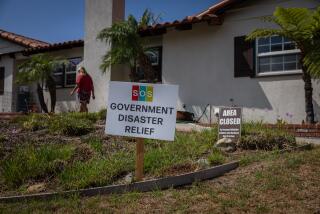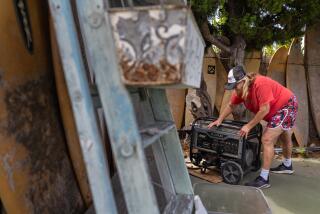Judge Hears Rival Views on Slide at La Conchita
More than three years after a devastating landslide dropped tons of mud and debris on La Conchita, attorneys for nearly 150 residents were in court Wednesday seeking $24 million in damages from the operators of a farm located on a bluff high above their neighborhood.
The March 1995 landslide, caused when a soggy slope busted loose, destroyed nine homes and rendered the remainder of the property in this seaside community north of Ventura nearly worthless.
The whodunit focuses on where to place the blame for the slide.
Was it an act of God, a fitful spasm of nature? Or did the farm atop the 600-foot-high bluff cause it by negligently running its irrigation system until the saturated hillside collapsed?
The outcome of the case depends on how Ventura County Superior Court Judge Henry J. Walsh answers those questions in this nonjury trial.
In his opening statement, delivered before a packed courtroom, San Diego attorney John F. McGuire zeroed in on La Conchita Ranch Co., which has operated the citrus and avocado farm perched above the community since 1975.
Ancient landslides had occurred in the area, but the slope had held up well against tides, quakes and floods until the ranch began operating, McGuire told the judge. As the trees grew, they needed more water, so the 688-acre farm switched to a new irrigation method, resulting in twice as much water applied to the soil. Between 1987 and 1990, McGuire said water consumption tripled, as did farm profits.
In 1989, a small slide occurred on ranch property. McGuire said a geological consultant hired by the ranch recommended that two tests be performed to measure the amount of water in the soil and the stability of the slope, but the ranch failed to do them.
Two more slides followed in 1991, and La Conchita homeowners threatened lawsuits. But instead of reducing the risk, McGuire said, farm owners sought to reduce liability by reorganizing the company into a limited partnership.
By June 1994, fissures surfaced along a road on the slope, presaging the origin of the giant landslide. Springs were flowing at the base of the hill. Attorneys for the farm drafted a letter to warn residents, but the farm never sent it, McGuire said. Instead, he contends, the farm continued irrigating until December.
After a rainy January, the slope weakened further. The dramatic climax to the attorney’s presentation Wednesday came in a home video of the March 4, 1995, landslide shown to the court. In it, the first two of three massive slides crash into La Conchita as terrified voices scream, “Oh my God, oh my God! There goes my house! Look at that. That’s radical. Oh my God!”
Today,many homes are still standing, but the community is filled with county signs warning of the ongoing geologic hazard. Residents are told to “Enter At Your Risk.”
“No one can get a loan, no one can refinance; people with second mortgages had them cut,” McGuire said.
To compensate for the losses, attorneys for 146 La Conchita residents seek $16 million for property damage along with $8 million to cover past and future loss of enjoyment of property. They also want the slope shored up to prevent further sliding.
Frank Sabaitis, an attorney from Los Angeles representing La Conchita Ranch, said nature, not the farm operation, is to blame.
The defense rests largely on two pillars: Natural forces have been chewing away the slope for centuries, and careful irrigation techniques at the farm could not have led to soil saturation that caused the hillside to fail.
“It was a disaster. The end will show, however, this was a natural disaster,” Sabaitis told the judge. “The defendants acted more than reasonably under all circumstances. This was a continuation of a geologic progression that had been ongoing for eons.”
According to experts he consulted, Sabaitis said, big landslides have historically occurred in the hills above town. The terrain is steep and consists of crumbly marine deposits. In 1909, a big slide wiped out a rail line, killing four people near La Conchita, he said.
Showing old photos to the court, Sabaitis said existing roads were covered by dirt, raising the elevation of the north side of town by up to four feet in the 20th century.
On the bluff, the farm took care to reduce water consumption, Sabaitis said. Ranch workers carefully monitored soil conditions. Drip irrigation was used to dispense carefully measured quantities of water on tree roots. Irrigation only occurred an average of once every 20 days and was not used during rainy months, he said.
“This is a case of irrigation management,” Sabaitis repeatedly told the judge.
Natural seeps and springs occur at the base of the slope and had been active for years, according to experts hired by La Conchita Ranch. Tests by the experts showed that the water was not from agriculture, but occurred naturally in the mountain.
Several large aquifers inside the mountain are responsible for destabilizing the soil, he said. Record rainfall in January 1995, a few weeks before the landslide occurred, also contributed, Sabaitis said.
When signs of slippage began to appear on the slope, the ranch hired technical consultants and installed pipes to remove water from the area, Sabaitis said. Between 1988 and 1995, the company spent $760,000 on studies and dewatering projects, he added.
To make sense of the conflicting claims, Walsh has organized the trial into two phases.
To win the first phase, homeowners’ lawyers must show that irrigation water filled the underground aquifers in the slope above La Conchita and that an overfilled aquifer led to the collapse of the slope. If they prevail, the second phase of the trial will focus on damages.
The first phase of the trial is expected to last three weeks. The trial continues today.
More to Read
Sign up for Essential California
The most important California stories and recommendations in your inbox every morning.
You may occasionally receive promotional content from the Los Angeles Times.










